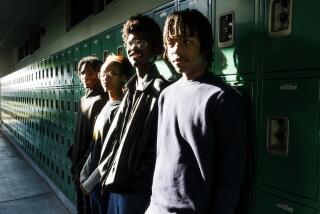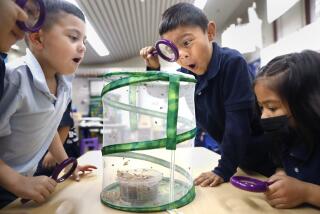‘Si o No?’
- Share via
NORTH HILLS — A third-grade classroom is a third-grade classroom is a third-grade classroom, and no great feat of imagination is required to conjure up Room 32 at Noble Elementary, a giant L.A. Unified school in the flats of the San Fernando Valley. The floors, of course, are beige linoleum, the walls a pale yellow.
The names of the children are printed in a corner of a dusty chalkboard, a few of them punctuated with little happy faces signifying some sort of accomplishment. Construction paper cutouts of hearts and snowflakes dangle from a string stretched over the class pencil box. The shelves hold books about shipwrecks and pumpkins.
The children are third-graders, and is that not description enough? They fidget, sit on their feet and fold little fingers around stubby pencils, sweating out an exercise in mathematics. One by one, they finish and raise a hand high in triumph, calling out, “Teacher, teacher, teacher!” The biggest boy in class has a question about extra lunch tickets. The smartest girl passes answers on the sly to her table-mates. Third-graders.
There are, however, a few things some Californians might find exceptional about Room 32. Below each of the large alphabet letters that decorate the room, for example, are appropriate words written in Spanish, from aguila to zoologico. The title of the shipwreck book is “En Busca del Titanic.” The pencil box bears the marking “lapices.” And the children--Marisol, Humberto, Angela--answer the teacher’s questions in Spanish, with the exception, of course, of the smartest girl, who daringly sprinkles in English.
*
Yes, this is it, folks, the devil’s lair, a hideaway for the latest hobgoblin in California politics. Here, in this otherwise familiar classroom, bilingual education is being practiced. Call the National Guard. Dial 911 (that’s nueve, uno, uno, kids). Sign the petition and put up a proposition to halt this madness, whatever it is. Whatever it is.
What is bilingual education? Predictably enough, this question already has been eclipsed in the exploding debate over whether to eliminate it. And thus this trip to Room 32, where the teacher, Darci Knight, daughter of a longtime friend, has agreed to offer a primer of sorts.
Acquiring language, begins this 10-year veteran of bilingual teaching, is a mysterious human feat. Linguistic experts have found that part of it is a matter of drill and part a process more like osmosis. It takes time. Most children still are getting the hang of it even after five, six, seven years.
In California, one in five children comes to school speaking little or no English. What to do? Some people say toss them into deep water, let them swim or sink with English. In fact, they can learn this way, but it still takes time. While the other children learn to do math, the non-English-speakers will learn the word “math.” Says Knight: “They spend three, four years listening, slowly acquiring language, word by word, not learning any content. The whole year is going to be lost, as is the next, as is the next. Then maybe they are on an even keel. After three years, they speak English--but they have missed three years of subjects like geography.”
*
Bilingual education attempts to teach children in their native tongue until they acquire enough English to learn in what Americans consider the mother tongue. Knight offers a parable. Imagine, she says, a talented auto mechanic who moves from America to Russia. He speaks no Russian, but enrolls in automotive school. He knows the essential concepts--how a carburetor works, where the transmission is located--so all he will need are the appropriate Russian words. It’s a translation job.
“But what happens,” she says, “if the same mechanic enrolls in something he knows nothing about, say cooking school. Now he will fail, because he doesn’t have the language to learn the concepts. He will become frustrated, sitting in the back of class, unable to understand what is going on. And pretty soon he will lose interest.”
Make no mistake. Knight is not blind to blunders that have been made with bilingual education, particularly within L.A. Unified. For a decade, she has lived with mix-and-match approaches, poor communication with parents, a shortage of qualified staff. Execution and educational theory, of course, are two distinctly different topics--a fine point destined to be overlooked in the coming debate.
It seems clear to Knight, as others, that the anti-bilingual education proposition planned for the June ballot will be almost impossible to beat. The fight at its heart will not be about linguistics and learning. It will be about more emotional themes, about patriotism and “official” languages. It will be, as Knight put it, about “those people, quote-unquote.” Veterans of Proposition 187 will know what that means.
More to Read
Sign up for Essential California
The most important California stories and recommendations in your inbox every morning.
You may occasionally receive promotional content from the Los Angeles Times.











